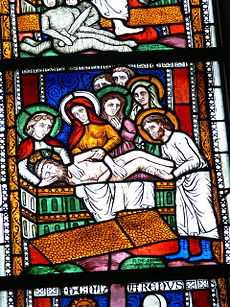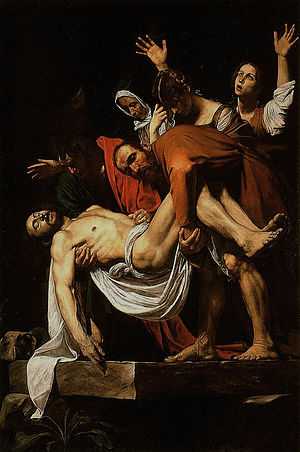Burial of Jesus
| Events in the |
| Life of Jesus according to the Gospels |
|---|
 |
|
In rest of the NT |
|
Portals: |
The burial of Jesus refers to the burial of the body of Jesus after crucifixion, described in the New Testament. According to the canonical gospel accounts, he was placed in a tomb by a man named Joseph of Arimathea.
Biblical accounts
The earliest reference is in a letter of Paul. Writing to the Corinthians around the year 54 CE,[1] he refers to the account he had received of the death and resurrection of Jesus ("and that he was buried, and that he was raised on the third day according to the Scriptures").[2]
The next generation of writings are the four canonical gospels, written between 66 and 95CE, all of which conclude with an extended narrative of Jesus' arrest, trial, crucifixion, burial, and resurrection.[3]:p.91 All four state that, on the evening of the Crucifixion, Joseph of Arimathea asked Pilate for the body, and, after Pilate granted his request, he wrapped it in a linen cloth and laid it in a tomb.
There are significant differences between the four accounts, recording the evolution of the tradition from the earliest gospel (that of Mark to the last (the Gospel of John).[4] Modern scholarship tends to see the gospel accounts as contradictory, and finds the Mark portrayal more probable.[5][6]
Gospel of Mark
In the earliest of the gospels, the Gospel of Mark, written around 70CE,[7][8] Joseph of Arimathea is a member of the Jewish Council – the Sanhedrin which had condemned Jesus – who wishes to ensure that the corpse is buried in accordance with Jewish law, according to which dead bodies could not be left exposed overnight. He puts the body in a shroud and lays it in a tomb carved into the rock.[5] The Jewish historian Josephus, writing later in the century, described how the Jews regarded this law as so important that even the bodies of crucified criminals would be taken down and buried before sunset.[9] In this account, Joseph does only the bare minimum needed for observance of the law, wrapping the body in a cloth, with no mention of washing or anointing it. This may explain why Mark has a story prior to the Crucifixion, in which a woman pours perfume over Jesus (Mark 14:3-9): Jesus is thereby prepared for burial even before his death.[10]
Gospel of Matthew
The Gospel of Matthew was written around the year 85 or 90, using the Gospel of Mark as a source.[11] In this account Joseph of Arimathea is not a member of the Sanhedrin, but a wealthy disciple of Jesus.[12][13] Many interpreters have read this as a subtle orientation by the author towards wealthy supporters.[13] This version suggests a more honourable burial: Joseph wraps the body in a clean shroud and places it in his own tomb, and word used is soma (body) rather than ptoma (corpse).[14] The author adds that the Roman authorities "made the tomb secure by putting a seal on the stone and posting the guard." This detail may have been added to answer claims by contemporary opponents that the followers of Jesus had stolen his body.[15]
Gospel of Luke
The Gospel of Mark is also a source for the account given in the Gospel of Luke, written around the year 90.[16] As in the Mark version, Joseph is a member of the Sanhedrin rather than a follower, but here he is described as not having agreed with the verdict on Jesus.[17]
Gospel of John
The last of the gospels, John, differs from Mark on this point, depicting Joseph as a disciple who gives Jesus an honourable burial. John says that Joseph was assisted in the burial process by Nicodemus, who brought a mixture of myrrh and aloes and included these spices in the burial cloth according to Jewish customs.
Historicity
N. T. Wright notes that the burial of Christ is part of the earliest gospel traditions.[18] John A.T. Robinson states that the burial of Jesus in the tomb is one of the earliest and best-attested facts about Jesus."[19] Rudolf Bultmann described the basic story as 'an historical account which creates no impression of being a legend'.[20]
John Dominic Crossan, however, suggests that Jesus' body was eaten by dogs as it hung on the cross so that there was nothing left to bury.[21] Martin Hengel argued that Jesus was buried in disgrace as an executed criminal who died a shameful death, a view widely accepted in scholarly literature.[20]
Theological significance
Paul the Apostle includes the burial in his statement of the gospel in verses 3 and 4 of 1 Corinthians 15: "For I delivered unto you first of all that which I also received, how that Christ died for our sins according to the scriptures; And that he was buried, and that he rose again the third day according to the scriptures" (KJV). This appears to be an early pre-Pauline credal statement.[22]
The burial of Christ is specifically mentioned in the Apostles' Creed, where it says that Jesus was "crucified, dead, and buried." The Heidelberg Catechism asks "Why was he buried?" and gives the answer "His burial testified that He had really died."[23]

The Catechism of the Catholic Church states that, "It is the mystery of Holy Saturday, when Christ, lying in the tomb, reveals God's great sabbath rest after the fulfillment of man's salvation, which brings peace to the whole universe" and that "Christ's stay in the tomb constitutes the real link between his passible state before Easter and his glorious and risen state today."[24]
Depiction in art
| Part of a series on |
| Death and Resurrection of Jesus |
|---|
 |
|
Miscellaneous
|
|
Portals: |
The Entombment of Christ has been a popular subject in art, being developed in Western Europe in the 10th century. It appears in cycles of the Life of Christ, where it follows the Deposition of Christ or the Lamentation of Christ. Since the Renaissance, it has sometimes been combined or conflated with one of these.[25]
Notable individual works with articles include:
- The Entombment (Michelangelo)
- The Deposition (Raphael)
- The Entombment (Bouts)
- The Entombment (Titian, 1525)
- The Entombment (Titian, 1559)
- The Entombment of Christ (Caravaggio)
- Lamentation of Christ (Rogier van der Weyden)
Use in hymnody
The African-American spiritual Were you there? has the line "Were you there when they laid Him in the tomb?"[26] while the Christmas carol We Three Kings includes the verse:
Myrrh is mine, its bitter perfume
Breathes a life of gathering gloom;
Sorrowing, sighing, bleeding, dying,
Sealed in the stone cold tomb.
John Wilbur Chapman's hymn "One Day" interprets the burial of Christ by saying "Buried, He carried my sins far away."[27]
See also
| Wikimedia Commons has media related to Entombment of Christ. |
- Tomb of Jesus, multiple sites purported to be Christ's burial place
- Descent from the Cross
- Empty tomb
- Epitaphios (liturgy)
- Life of Jesus in the New Testament
- Harrowing of Hell
References
- ↑ Watson E. Mills, Acts and Pauline Writings, Mercer University Press 1997, page 175.
- ↑ 1COR 15:3-4
- ↑ Powell, Mark A. Introducing the New Testament. Baker Academic, 2009. ISBN 978-0-8010-2868-7
- ↑ Matthew 27:57–61, Mark 15:42–47, Luke 23:50–56, John 19:38–42
- ↑ 5.0 5.1 Douglas R. A. Hare, Mark (Westminster John Knox Press, 1996) page 220.
- ↑ Maurice Casey, Jesus of Nazareth: An Independent Historian's Account of His Life and Teaching (Continuum, 2010) page 449.
- ↑ Witherington (2001), p. 31: 'from 66 to 70, and probably closer to the latter'
- ↑ Hooker (1991), p. 8: 'the Gospel is usually dated between AD 65 and 75.'
- ↑ James F. McGrath, "Burial of Jesus. II. Christianity. B. Modern Europe and America" in The Encyclopedia of the Bible and Its Reception. Vol.4, ed. by Dale C. Allison Jr., Volker Leppin, Choon-Leong Seow, Hermann Spieckermann, Barry Dov Walfish, and Eric Ziolkowski, (Berlin: de Gruyter, 2012), p.923
- ↑ McGrath, 2012, p.937
- ↑ Harrington (1991), p. 8.
- ↑ Daniel J. Harrington, The Gospel of Matthew (Liturgical Press, 1991) page 406.
- ↑ 13.0 13.1 Donald Senior, The Passion of Jesus in the Gospel of Matthew (Liturgical Press, 1990) page 151.
- ↑ Donald Senior, The Passion of Jesus in the Gospel of Matthew (Liturgical Press, 1990) page 151-2.
- ↑ Harrington (1991), p. 407.
- ↑ Davies (2004), p. xii.
- ↑ N. T. Wright, Luke For Everyone (Westminster John Knox Press) page 286.
- ↑ Wright, N. T. (2009). The Challenge of Easter. p. 22.
- ↑ Robinson, John A.T. (1973). The human face of God. Philadelphia: Westminster Press. p. 131. ISBN 978-0-664-20970-4.
- ↑ 20.0 20.1 Magness, Jodi (2011). Stone and Dung, Oil and Spit: Jewish Daily Life in the Time of Jesus. Eerdmans. p. 146.
- ↑ Crossan, John Dominic (2009). Jesus: A Revolutionary Biography. p. 143.
- ↑ Hans Conzelmann, 1 Corinthians, translated James W. Leitch (Philadelphia: Fortress, 1969), 251.
- ↑ Heidelberg Catechism, Q & A 41.
- ↑ Catechism of the Catholic Church, 624-625.
- ↑ G Schiller, Iconography of Christian Art, Vol. II,1972 (English trans from German), Lund Humphries, London, p.164 ff, ISBN 0-85331-324-5
- ↑ Cyberhymnal: Were You There?
- ↑ Cyberhymnal: One Day
